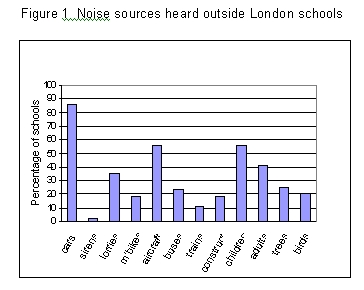ASA/CAA '05 Meeting, Vancouver, BC



Environmental Noise and Children's Academic Attainments
Bridget Shield1 - shieldbm@lsbu.ac.uk
Julie Dockrell2
1Department of Engineering Systems
Faculty of Engineering Science and Built Environment
London South Bank University
London SE1 0AA, UK
2School of Psychology and Human Development
Institute of Education
University of London
London WC1H 0AA, UK
Popular version of paper 1aAA10
Presented Monday morning, May 16, 2005
Joint ASA/CAA Meeting, Vancouver, BC
Is school a sound learning environment for our children? Recent research in
London (UK) has shown that high levels of environmental noise outside schools
reduce children's scores in standardised nationwide academic tests.
In a survey of noise levels outside 142 primary schools within five miles of
central London 65% of the schools were found to be exposed to levels in excess
of those recommended by the World Health Organisation. Over 85% of the schools
surveyed were exposed to noise from road traffic (schools in areas exposed to
high levels of aircraft noise were excluded from the survey). The most commonly
occurring sources of noise outside the schools are shown in Figure 1.

Children in England and Wales sit nationally standardised tests (SATs) at the ages of 7 and 11. At the age of 7 children are tested in Reading, Writing, Spelling and Mathematics; and at the age of 11 in English, Mathematics and Science. To examine whether environmental noise has any effect on children's academic attainments we compared the noise levels measured outside each school with the published test scores (that is, percentages of children achieving a target level) for each school. We found significant negative relationships between noise and SATs scores, particularly for the schools exposed to the higher levels of noise. In other words, in general, the higher the external noise level, the less well the school performed in the tests.
The older (11 year old) children appeared to be more affected by noise than the younger children. This may reflect the nature of the tests at the different ages; the older children sit nationwide examinations while the assessments of the younger children include less formal tests and teacher assessments.
Another interesting aspect of the analysis was that the test scores were more closely related to the peaks of the noise than to the general overall noise. This could be because the children are distracted by the noise of individual events (such as passing trucks or motorbikes), which may explain why the examinations taken by the older children are more affected by noise than the assessments of the younger children.
Figure 2 illustrates the relationships between noise and test scores for the older children; Figure 2a shows the average scores over all subjects, while Figure 2b shows the Mathematics scores.

Of course there are many other factors, apart from noise, which affect a school's performance in academic tests. These include issues such as language and social deprivation. However, we found that even when controlling the data to take account of these factors, there were still significant relationships between noise and test scores.
These results have important implications for the design of schools. In the US and UK there are new standards for the acoustic design of schools, aimed at reducing both internal and external noise in classrooms. Unfortunately many architects and school design teams are still unwilling, for reasons of cost, aesthetics or ignorance, to comply with the guidelines. However, the results of our research, plus those of other similar projects, show that in order to optimise children's academic performance at school, noise in schools must be kept to a minimum. This can be achieved by careful siting and planning of new schools, and by suitable acoustic treatment of new and existing schools.